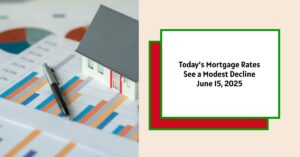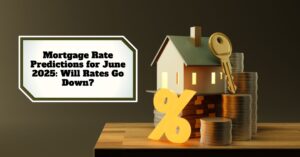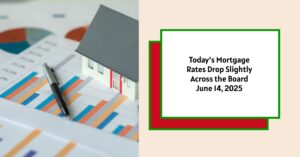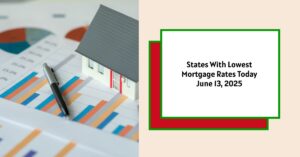Are you glued to your computer screen, watching mortgage refinance rates like a hawk? You're not alone! As of June 15, 2025, the national average for a 30-year fixed refinance is around 7.12%. That's a dip of 3 basis points from the previous day and 10 basis points from last week, according to Zillow's latest data. But the million-dollar question is: Does that mean you should refinance your mortgage today?
Let's cut through the noise and dive deep into what these numbers actually mean for you and your financial future.
Mortgage Refinance Rates Today – June 15, 2025: Is Now the Time to Refi?
Refinance Rates Snapshot: June 15, 2025
Okay, let’s get down to the nitty-gritty. Here's a quick look at some of the rates you'll find out there today, and how they've been trending:
- 30-Year Fixed Refinance: 7.12% (Down 3 basis points from previous day, Down 10 basis points from last week)
- 15-Year Fixed Refinance: 6.02% (Down 1 basis point from previous day)
- 5-Year ARM Refinance: 5.94% (Unchanged from previous day)
A Deeper Dive: Refinance Rates by Loan Type
It's important to remember that the “average” rate is just that – an average. Your actual rate will depend on various factors, including your credit score, loan-to-value ratio (LTV), and the type of loan you're refinancing. Here's a more detailed look at different loan types, along with weekly changes:
Conforming Loans
| PROGRAM | RATE | 1W CHANGE | APR | 1W CHANGE |
|---|---|---|---|---|
| 30-Year Fixed Rate | 6.93% | down 0.05% | 7.39% | down 0.06% |
| 20-Year Fixed Rate | 6.70% | down 0.13% | 6.97% | down 0.27% |
| 15-Year Fixed Rate | 6.01% | down 0.05% | 6.31% | down 0.06% |
| 10-Year Fixed Rate | 6.03% | up 0.10% | 6.13% | down 0.04% |
| 7-year ARM | 7.63% | down 0.19% | 8.09% | down 0.14% |
| 5-year ARM | 7.05% | down 0.57% | 7.66% | down 0.34% |
| 3-year ARM | – | 0.00% | – | 0.00% |
Government Loans
| PROGRAM | RATE | 1W CHANGE | APR | 1W CHANGE |
|---|---|---|---|---|
| 30-Year Fixed Rate FHA | 7.03% | up 0.33% | 8.06% | up 0.34% |
| 30-Year Fixed Rate VA | 6.56% | down 0.02% | 6.78% | 0.00% |
| 15-Year Fixed Rate FHA | 5.94% | up 0.18% | 6.91% | up 0.17% |
| 15-Year Fixed Rate VA | 5.97% | down 0.02% | 6.33% | up 0.03% |
Jumbo Loans
| PROGRAM | RATE | 1W CHANGE | APR | 1W CHANGE |
|---|---|---|---|---|
| 30-Year Fixed Rate Jumbo | 7.60% | down 0.26% | 7.76% | down 0.53% |
| 15-Year Fixed Rate Jumbo | 6.25% | down 0.32% | 6.30% | down 0.70% |
| 7-year ARM Jumbo | – | 0.00% | – | 0.00% |
| 5-year ARM Jumbo | 9.25% | up 0.06% | 8.87% | down 0.01% |
| 3-year ARM Jumbo | – | 0.00% | – | 0.00% |
Important Considerations:
- APR vs. Interest Rate: Pay close attention to the APR (Annual Percentage Rate). This includes not just the interest rate, but also other fees associated with the loan, giving you a more accurate picture of the total cost.
- Loan Type Matters: As you can see, rates vary significantly based on the type of loan. FHA and VA loans often have different requirements and can be attractive options for some borrowers. Jumbo loans, which are for larger loan amounts, typically have higher rates.
- ARM Volatility: Adjustable-rate mortgages (ARMs) can be tempting with their initially lower rates. However, remember that these rates can change over time, potentially increasing your monthly payments. Consider if you can stomach the possible hikes if the market changes.
Is Refinancing Right for You? Asking the Tough Questions.
Okay, so rates are changing – but does that automatically mean you should refinance? Absolutely not. It all boils down to your individual circumstances. Here are some key questions to ask yourself:
- What are your goals? Are you looking to lower your monthly payment, shorten your loan term, or tap into your home equity? Your goals will influence the type of refinance that makes the most sense.
- How long do you plan to stay in your home? Refinancing involves closing costs. If you're only planning to stay in your home for a few years, you might not recoup those costs before you move. A good rule of thumb is the “break-even point” – how long will it take for your savings to outweigh the closing costs?
- What is your current interest rate compared to today's rates? A general guideline is that a refinance is worth considering if you can lower your interest rate by at least 0.5% to 1%.
- What is your credit score? A higher credit score typically qualifies you for a better interest rate. If your credit score has improved since you took out your original mortgage, refinancing could be a smart move.
- Can you afford the closing costs? Factor in all the costs associated with refinancing, including appraisal fees, origination fees, and title insurance. These can add up quickly, so you need to be sure the savings justify the expense.
Recommended Read:
Best Time to Refinance Your Mortgage: Expert Insights
Mortgage Refinance Rates on June 14, 2025: A Jump of 5 Basis Points
Beyond the Numbers: Hidden Benefits of Refinancing
While lower interest rates are often the primary motivation for refinancing, there are other potential benefits to consider:
- Switching Loan Types: Perhaps you want to switch from an adjustable-rate mortgage (ARM) to a fixed-rate mortgage for more stability. Or maybe you want to eliminate Private Mortgage Insurance (PMI) by refinancing once you have enough equity in your home.
- Debt Consolidation: You could refinance and roll other high-interest debts, like credit card debt, into your mortgage. This could simplify your finances and potentially save you money (but be careful not to extend the debt burden for too long).
Why Experience and Trust Matter in the Mortgage World
Let's be honest – the mortgage world can be confusing. That's why it's crucial to rely on experienced and trustworthy professionals. I've seen firsthand how the right advice can make a huge difference in someone's financial well-being.
Beware of lenders who make unrealistic promises or pressure you into making a quick decision. A reputable lender will take the time to understand your situation, answer your questions, and provide you with clear and transparent information. Talk to multiple lenders.
My Two Cents: A Word of Caution and Optimism
While the slight dip in rates today is encouraging, it's important to remember that mortgage rates are constantly fluctuating. Nobody has a crystal ball to predict where they'll be tomorrow.
Therefore, don't try to time the market perfectly. Instead, focus on your own financial situation and make a decision that makes sense for you based on your goals and risk tolerance.
The Bottom Line:
Keep a close eye on the rates and do your homework.
Maximize Your Mortgage Decisions in 2025
Thinking about whether to refinance now? Timing is critical, and having the right strategy can save you thousands over the life of your loan.
Norada's team can guide you through current market dynamics and help you position your investments wisely—whether you're looking to reduce rates, pull out equity, or expand your portfolio.
HOT NEW LISTINGS JUST ADDED!
Talk to a Norada investment counselor today (No Obligation):
(800) 611-3060
Recommended Read:
- When You Refinance a Mortgage Do the 30 Years Start Over?
- Should You Refinance as Mortgage Rates Reach Lowest Level in Over a Year?
- NAR Predicts 6% Mortgage Rates in 2025 Will Boost Housing Market
- Mortgage Rates Predictions for 2025: Expert Forecast
- Half of Recent Home Buyers Got Mortgage Rates Below 5%
- Mortgage Rates Need to Drop by 2% Before Buying Spree Begins
- Will Mortgage Rates Ever Be 3% Again: Future Outlook
- Mortgage Rates Predictions for Next 2 Years
- Mortgage Rate Predictions for Next 5 Years
- Mortgage Rate Predictions for 2025: Expert Forecast











